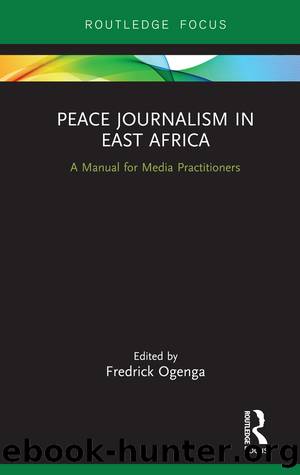Peace Journalism in East Africa by Fredrick Ogenga

Author:Fredrick Ogenga [Ogenga, Fredrick]
Language: eng
Format: epub
ISBN: 9780367250683
Google: gUqpwwEACAAJ
Goodreads: 44766366
Publisher: Routledge
Published: 2019-01-15T03:40:39+00:00
Media, terrorism, and peacebuilding in Africa
Terrorism has been defined differently by different scholars but the master narrative of what constitutes terrorism has been constructed by the media. Much of what the media has relied on is the idea of negativity and sensationalism, a representation strategy that has been exported to Africa for covering incidences of terrorism. This is reminiscent of the manner in which Africa has generally been negatively represented by the Western media.19 The narrative about the continent has been dominated by references to disease, failed states, poverty, and conflicts. However, the question is, Who is responsible for the invention of this negative narrative about Africa?
While poverty and disease are largely perceived as an African problem, the case of terrorism is more complicated. This is because while the historical trajectory of the African continent reminds us of colonialism and slavery, which are arguably forms of terrorism, Africa is historically littered with narratives about Africans terrorizing their own during territorial expansions and inter-ethnic conflicts. More recently, identity conflicts sanctioned by the state and civilians have taken place, such as the 2007 and 2017 postelection violence in Kenya and the 1994 genocide in Rwanda. However, the notion of terrorism in Africa is largely âforeignâ and can be quickly traced from colonial struggles that gave birth to nationalist movements and nationalist media agitating for freedom. It was also not unusual for colonial authorities to label nationalist/liberation movements such as Mau Mau of Kenya, Maji Maji of Tanzania, and Umkhonto we Sizwe in South Africa as âterrorists.â Is there a way Africa can reclaim its historicity in the context of such dominant negative representations? Scholars would premise their arguments on the role of colonialism and slavery; colonialism contributed largely to the negative discourse and the idea of the âdark continentâ as explorers and missionaries scrambled for a piece of Africa under the guise of âenlighteningâ the natives. It is the extension of this narrative, as advanced by the local and foreign media, which would compel keen observers to have quick answers and conclusions to the reasons behind the negative representation of Africa.
The Kenyan press has often presented news about terrorism in an alarming manner, often using bold headlines, red colors to indicate terror hot spots, and graphic images of the extent of damage immediately after terrorist attacks. This is well illustrated by the Daily Nation of July 9, 2015, when the statistics on casualties of terrorism in Kenya were displayed prominently using bold front-page headlines and graphic images of victims carried in body bags by the Red Cross rescue teams. The article uses a map of Kenya to illustrate ungovernable spaces between Kenya and Somalia â apparently due to al-Shabaab attacks â in red, symbolic of the chaotic situation there. Kenyans largely rely on mainstream newspapers for accurate information to help them come to terms with serious events affecting the country, such as terrorism. This is not to argue that if the media stops publicizing terrorism terrorists will not attack. Terrorists may still attack even with limited or no media coverage.
Download
This site does not store any files on its server. We only index and link to content provided by other sites. Please contact the content providers to delete copyright contents if any and email us, we'll remove relevant links or contents immediately.
Index to the London Magazine by Frank P. Riga Claude A. Prance(191)
Female Impersonation by Carol-Anne Tyler(135)
Creativity and Feature Writing by Ellie Levenson(124)
A Filtered Life by Nicole Taylor Mimi Nichter(120)
Xenolinguistics; Towards a Science of Extraterrestrial Language by Douglas A. Vakoch & Jeffrey Punske(118)
Theories of Journalism in a Digital Age by Steen Steensen Laura Ahva(114)
Critical Communication Pedagogy by Fassett Deanna L.;Warren John T.; & John T. warren(111)
Torture, Intelligence and Sousveillance in the War on Terror by Vian Bakir(109)
Developing Translanguaging Repertoires in Critical Teacher Education by Zhongfeng Tian Nicole King(107)
Origin Of Ethnography In Japan by Minoru Kawada(105)
Computing the News: Data Journalism and the Search for Objectivity by Sylvain Parasie(103)
Peace Journalism in East Africa by Fredrick Ogenga(100)
Transformative Media Pedagogies by Paul Mihailidis Sangita Shresthova Megan Fromm(99)
Matter Transmission by Nicolás Salazar Sutil(94)
A Networked Self and Platforms, Stories, Connections by Zizi Papacharissi(92)
Media Audiences by Sue Turnbull(92)
Revisiting Transnational Broadcasting by Nelson Ribeiro Stephanie Seul(91)
Media Studies 2.0 by William Merrin(91)
The Gentrification of the Internet by Jessa Lingel(88)
